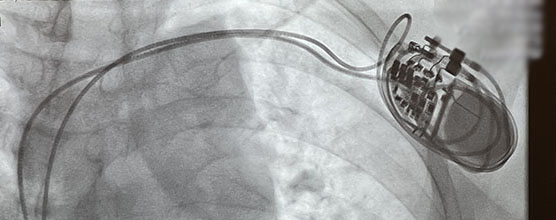
Call Us: 011 475 7654



Cardiac pacing involves devices implanted into the heart or chest to control heartbeat irregularities or arrhythmias. A pacemaker is the most common cardiac pacing device and uses electrical stimulation to control the heartbeat.
Pacemakers are electrical devices made of two parts that control issues with your heart's electrical signals causing an irregular heartbeat. In the heart, you have two chambers and the sinoatrial and atrioventricular nodes. The chambers all beat together in the same rhythm, controlled by the sinoatrial and atrioventricular nodes. However, when there are issues with these nodes, you can develop sick sinus syndrome or heart block that may require a pacemaker.
Pacemakers are primarily used to restore function to the heartbeat, but they can also help address several other issues, such as:
We assess whether you will need a pacemaker or not by performing various comprehensive tests and assessments. This may include an electrocardiogram, an echocardiogram and stress tests.
Pacemakers can be either short-term or long-term, depending on how severe your condition is. At Westrand Cardiovascular Centre, we consider all factors before providing a comprehensive treatment programme, including pacemaker insertion.
These are used in the case of an acute event whereby you need an immediate pacemaker for a very short period of time - a few days at most - while waiting for a permanent pacemaker.
These are long-term solutions to conditions such as heart block and sick sinus syndrome.
Other types of pacemakers include:
The pacemaker procedure takes place in the hospital theatre for sterility, X-ray and anaesthetic reasons. You will receive local anaesthesia to the area and light sedation if necessary to ensure your comfort during the procedure.
The pacemaker generating unit (battery) is placed below the skin under the left clavicle, and leads are implanted into the heart. Once implanted, the pacemaker is set to stimulate the heart through electrical impulses. However, these can be adjusted at any time.
There are two ways to implant a pacemaker:
This is the most common method for implanting a pacemaker and uses catheters to transport wires and electrodes to your heart through a vein in the neck or groin. This procedure can be done at our advanced clinic or in hospital.
During the procedure, you will be required to change into a hospital gown and lie on the patient bed. We will provide you with local anaesthesia and numb the area receiving the wires and electrodes. Then, a small incision is made into the vein, and the wires are fed through it until they reach the heart.
Next, the electrodes are attached to the heart while the opposite ends are joined to the pulse generator. The pulse generator is a tiny electrical stimulator we implant just beneath the skin to control the heartbeat. Once in place and working, we will close the incision with a few stitches.
The health of your heart is continuously monitored throughout the procedure through X-rays. This also allows us to accurately feed the wires and electrodes.
Epicardial pacemaker insertion is an invasive procedure whereby the wires and electrodes are attached to the outer walls of the heart in open-heart surgery. Because of this, you will be given general anaesthesia to undergo the procedure.
This procedure is not as common as the transvenous method and is primarily used in specific cases, such as issues with the veins or a child needing a pacemaker.
During the procedure, our experienced team will make an incision to open the chest cavity and place the leads and electrodes on the oute walls. The pulse generator or pacemaker will then be placed close to the collarbone under the skin.
Once complete, we will stitch the skin and complete the procedure.
Although life-saving, pacemakers can have some complications and require special care.
Procedural risks:
Other things to keep in mind:
Our team will advise you on the best precautions after receiving your pacemaker. You will also receive a pacemaker identification card to carry and present when needed.
Book an appointment